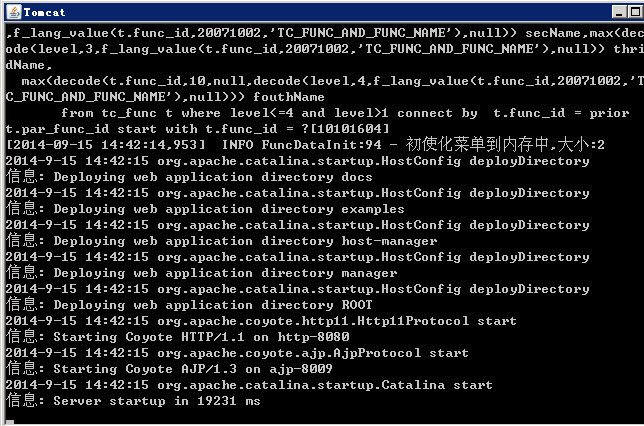Tomcat 集群
1. 前言
该篇中测试的机器发生了变更,在第一篇中设置的Apache DocumentRoot "d:/deployment"修改为了DocumentRoot d:/cluster 。这个不影响实际操作,just换了台电脑。
在第一篇中讲了apache整合tomcat的,该篇中将阐述tomcat的集群.

2. 集群的概念
集群分类
■ 纵向集群 :VERTICAL CLUSTER 多个tomcat部署在同一台服务机上,CPU资源需要抢占,只能对内存进行拓展
■ 横向集群 : HORIZONTAL CLUSTER tomcat和服务机一一对应,即一台服务器上部署一个tomcat。(可做大规模集群)
核心概念
■ 负载均衡 :LOAD BALANCE 依据每个节点对应的权重大小分配需要处理的数据
■ 高可用性 : HIGH AVAILABLE 实际运行中只有一台服务器在工作,当其挂掉后其他服务器顶上
Tomcat 官网给出的结构图 :

通过负载均衡,任务TASK分配给集群节点.
3. 集群
3.1 配置Apache
修改Apache httpd.conf 文件 ,去掉第一篇中文件末尾追加的内容,在其后面追加如下内容:
LoadModule jk_module modules/mod_jk-1.2.31-httpd-2.2.3.so
JKWorkersFile conf/workers.properties
JkLogFile logs/mod_jk.log
<VirtualHost *>
DocumentRoot d:/cluster
<Directory "d:/cluster/JMIE">
AllowOverride None
Order allow,deny
Allow from all
</Directory>
ServerAdmin ufida-hf:80
ServerName ufida-hf:80
DirectoryIndex index.html index.htm index.jsp index.action
ErrorLog logs/error_log.txt
CustomLog logs/access_log.txt common
JkMount /*WEB-INF cluster
JkMount /servlet/* cluster
JkMount /*.jsp cluster
JkMount /*.do cluster
JkMount /*.json cluster
JkMount /*.action cluster
</VirtualHost>
备注:这里发布的包名称为JMIE
在第一篇中使用的是 apj13 而这里使用的是cluster,那么这个cluster是哪里来的呢? 很显然是在worders.properties中进行配置,其内容如下:
worker.list = cluster #node1 worker.node1.port = 8009 worker.node1.host = localhost worker.node1.type = ajp13 worker.node1.lbfactor = 1 #node2 worker.node2.port = 9009 worker.node2.host = localhost worker.node2.type = ajp13 worker.node2.lbfactor = 1 #cluster worker.cluster.type = lb worker.cluster.balance_workers = node1,node2
worker.lbcontroller.sticky_session=0
worker.controller.sticky_session_force=false
worker.connection_pool_size=3000 worker.connection_pool_minsize=40 worker.connection_pool_timeout=10000
worker.node1.host = localhost
worker.节点名称.host 表示的为节点对应的主机名 ,这里为纵向集群,都是在本地配置,如果需要横向集群直接修改对应的host即可。
worker.cluster.type = lb
表示集群方式为负载均衡,其中worder.节点名称.lbfactor 表示节点对应的权重,权重越到处理的TASK越多,这里为1:1 即平均分配
worker.lbcontroller.sticky_session=0
worker.controller.sticky_session_force=false
保证session可在各节点进行复制,即关闭一台服务器后,我们登录系统的session会被转移到另外一台服务器上,客户端仍能正常操作。
worker.cluster.balance_workers = node1,node2
表示两个节点tomcat对应名称为node1,node2 。
3.2 配置TOMCAT
由上可以需要两个tomcat ,解压两个tomcat

修改tomcat node1 中的conf/server.xml文件
<Server port="8005" shutdown="SHUTDOWN">
节点2 在修改为8006
<Connector port="8080" protocol="HTTP/1.1" redirectPort="8443" />
节点2 修改为
<Connector port="9090" protocol="HTTP/1.1" redirectPort="9443" />
<Connector port="8009" protocol="AJP/1.3" redirectPort="8443" />
节点2 修改为
<Connector port="9009" protocol="AJP/1.3" redirectPort="9443" />

以上为设置tomcat在节点的名称,节点2修改为node2 ,随后在其下方加入:
<Cluster className="org.apache.catalina.ha.tcp.SimpleTcpCluster"
channelSendOptions="6">
<Manager className="org.apache.catalina.ha.session.BackupManager"
expireSessionsOnShutdown="false"
notifyListenersOnReplication="true"
mapSendOptions="6"/>
<Channel className="org.apache.catalina.tribes.group.GroupChannel">
<Membership className="org.apache.catalina.tribes.membership.McastService"
bind="127.0.0.1"
address="228.0.0.4"
port="45564"
frequency="500"
dropTime="3000"/>
<Receiver className="org.apache.catalina.tribes.transport.nio.NioReceiver"
address="auto"
port="4001"
selectorTimeout="100"
maxThreads="6"/>
<Sender className="org.apache.catalina.tribes.transport.ReplicationTransmitter">
<Transport className="org.apache.catalina.tribes.transport.nio.PooledParallelSender" timeout="60000"/>
</Sender>
<Interceptor className="org.apache.catalina.tribes.group.interceptors.TcpFailureDetector"/>
<Interceptor className="org.apache.catalina.tribes.group.interceptors.MessageDispatch15Interceptor"/>
<Interceptor className="org.apache.catalina.tribes.group.interceptors.ThroughputInterceptor"/>
</Channel>
<Valve className="org.apache.catalina.ha.tcp.ReplicationValve"
filter=".*\.gif;.*\.js;.*\.jpg;.*\.png;.*\.htm;.*\.html;.*\.css;.*\.txt;"/>
<ClusterListener className="org.apache.catalina.ha.session.ClusterSessionListener"/>
</Cluster>
节点2修改为4001 。
通过下图

可知道,为了集群,需要在应用中的web.xml末尾追加一个<distributable/>元素 。
3.3 Tomcat调优
通过以上的操作,集群环境已经成功搭建了,为了让tomcat能跑的更high,下面来对tomcat进行调优 。
3.3.1 优化启动参数
在tomcat的bin目录下修改catalina.bat 文件,在该文件头上追加如下信息
set JAVA_OPTS=-server -Xms1000M -Xmx1000M
其中 server 表示tomcat 允许在生产环境
-Xms 和 -Xmx 表示最小、最大JVM内存(如果是win32的系统会受到系统内存的限制) 两者设置为一样,可通过如下命令来测试其合适的值
java -Xmx1200m -version

该值需要手动设置 .
tomcat的启动参数还有很多,详细可自行查看官方文档:http://tomcat.apache.org/tomcat-7.0-doc/index.html
3.3.2 TOMCAT本身优化
将
<Connector port="8009" protocol="AJP/1.3" redirectPort="8443" />
替换为:
<!-- Define an AJP 1.3 Connector on port 8009 -->
<Connector port="8009" protocol="AJP/1.3" redirectPort="8443"
URIEncoding="UTF-8" minSpareThreads="25" maxSpareThreads="75"
enableLookups="false" disableUploadTimeout="true" connectionTimeout="20000"
acceptCount="300" maxThreads="300" maxProcessors="1000" minProcessors="5"
useURIValidationHack="false"
compression="on" compressionMinSize="2048"
compressableMimeType="text/html,text/xml,text/javascript,text/css,text/plain"
/>
解释如下:
<Connector port="8009" protocol="AJP/1.3" redirectPort="8443"
URIEncoding="UTF-8" 设置编码
minSpareThreads="25" 最大线程数
maxSpareThreads="75" 最小线程数
enableLookups="false" 关闭DNS查询
disableUploadTimeout="true"
connectionTimeout="20000"
acceptCount="300" 线程数达到maxThreads后,后续请求会被放入一个等待队列
maxThreads="300" 最大并发数
maxProcessors="1000"
minProcessors="5"
useURIValidationHack="false" 减少对url的不必要的检查
compression="on" 打开压缩功能
compressionMinSize="2048" 启用压缩的输出内容大小 默认为2KB
compressableMimeType="text/html,text/xml,text/javascript,text/css,text/plain" 压缩类型
/>
同样的道理也可以去修改8080端口,这里集群我们只需要用到8009端口,将节点2同样优化后可启动两个Tomcat
3.4 测试集群
将工程分别拷贝到两个TOMCAT中的webapps目录下

重启apache ,后启动两个tomcat


输入 http://192.168.1.5/JMIE 访问

关闭正在运行的tomcat后可发现扔可继续操作.
该篇结束
邮箱:steven9801@163.com
QQ: 48039387



